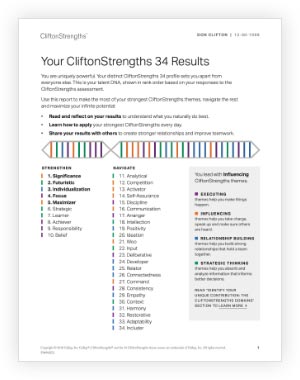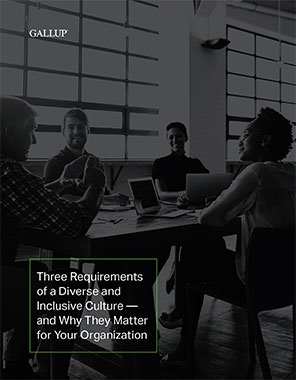Story Highlights
- Many businesses develop high-potential leaders only to lose them to competitors
- Talent development has an immediate and long-term value
Developing top talent is expensive.
Consider a mid-sized company of 5,000 employees and assume that 5% of them are deemed high-potential leaders (or HiPos, as they're often called). A 2018 report showed that most companies spend an average of $4,000 and 39 hours developing each of those high-potential leaders. This would translate to spending about $1 million and 9,750 hours on your best and brightest future leaders.
That's a worthwhile investment when the return pays rich dividends -- but it rarely does. Gartner's research shows that 73% of HiPo programs don't yield any ROI because the talented leave no matter how much was spent on them.
Ominously, Gallup research indicates that turnover among highly talented employees who are not engaged is on par with turnover rates among less talented, disengaged employees.
When you get down to brass tacks, a HiPo program isn't worth it if it doesn't generate revenue. But Gallup's research and our work with clients show that HiPo programs can be well-oiled, profit-generating machines -- if leaders make six critical strategic shifts.
Shift 1: From Nominations to Objective Selections
A Corporate Research Forum study found that 73% of top global businesses identify HiPos based primarily on a single subjective nomination -- typically from the local manager.
Nominating direct reports to fill a high-potential talent program is a prime example of what is known as the "IKEA effect" -- a cognitive bias in which people most value what they helped create. Managers may place a disproportionately higher value on people they have personally groomed, which is not a rigorous assessment of talent.
Indeed, personal preferences aren't enough -- companies need a scientifically validated way of predicting performance. And they need to use it more broadly than they already do: If a company's HiPo list consists mainly of leaders from its headquarters or its first two or three layers of management, that company overlooks a great deal of its critical operational talent and future leaders.
Talented people aren't always tenured employees or those most visible in the organizational hierarchy.
As important as determining who should be on the list is who should not be. The Delphi method -- a technique based on multiple rounds of vetting and validation, led by a cross-functional group of advisers -- is a useful forecasting tool that can help leaders establish a broadly agreed-upon final list of potential talent. Importantly, these conversations should also rigorously test, question and debate why some on the list truly deserve a spot.
Shift 2: From Assignments to Experiences
Organizations typically appoint participants to assignments linked to company strategy or other high-profile projects during the HiPo program. These assignments are a great way to showcase presentation skills -- but not true leadership talent.
Here's why: If a significant part of the program involves presenting ideas and assignments to a "Shark Tank"-style jury of senior executives, leaders' focus may well be on the individual's presentation and performance rather than substance. They don't get the chance to investigate the most meaningful part of the participant's assignment: how they made sense of their experience and what they learned.
A far more enlightening approach to revealing a person's talents is to give them a "breakthrough experience."
The experience should be carefully selected and be in an area that the person has had limited or no exposure to. Whatever the individual learns -- even if the assignment fails -- is what they'll take forward from the program.
You already know what the person can do; that's how they were selected. You need to know how HiPos handle new experiences and how they use what they learn for future challenges. After all, the future is unpredictable, and how well we learn may become more important than what we know.
Shift 3: From Weaknesses to Strengths
Sometimes, top-talent programs are built around improving high-potential employees -- identifying their weaknesses and "areas of opportunity" and smoothing out their rough edges. But it's not a great idea. At best, fixing weaknesses creates mediocrity, while focusing on strengths uncovers areas of infinite potential.
Gallup research shows that strengths-based development helps companies realize up to 19% increased sales, 29% increased profit, 7% higher customer engagement -- and 72% lower attrition. When many HiPo programs have zero impact on keeping top talent despite their vast expense, that may be the most important statistic of all.
But the real benefit of honing strengths rather than fixing weaknesses is that it unleashes true potential. Strengths development is the compass that should guide the leadership journey -- during the talent program and beyond -- for everyone involved. Rising talent should use their strengths to maximize their learning style, and sponsors and mentors should use their strengths to guide this journey. People who know and use their strengths, Gallup finds, are six times more likely to be engaged at work. Managers have a role in this too -- they influence at least 70% of the variance in team engagement.
And the engagement of your top talent is worth its weight in gold.
Shift 4: From Captive Classrooms to Ongoing Learning
Leadership development programs are typically a blend of classroom and online learning and experiential training. Many top-talent programs have added key experiential elements to their training: junkets, field excursions or learning sessions at other companies. That's good experience, but a "one and done deal" is quickly forgotten.
Even an intense, high-energy and enriching five-day off-site program will largely fade in your HiPo's memory when they return to the reality of their work lives. Research shows that people forget 77% of what they learn six days after leaving the classroom. Participants need to tie their learning to their day-to-day work using 30-day, 60-day and one-year plans with clearly defined outcomes that reflect all of their learning.
Gallup research indicates that turnover among highly talented employees who are not engaged is on par with turnover rates among less talented, disengaged employees.
Managers can provide much of this support -- they have the best view of how program participants' contributions are being maximized. They are also in the best position to provide ongoing feedback and coaching and help top talent directly apply their learning to performance.
Shift 5: From Isolated Paths to Shared Journeys
Perhaps the most engaging part of a HiPo program is learning along with a cohort of other top talent. A strong sense of community and shared purpose is inspiring and motivating, and without it, the journey might seem mechanistic and lonely. And participants and practitioners sometimes create their own community that they can rely on for future learning and making sense of their collective experience.
Talented people aren't always tenured employees or those most visible in the organizational hierarchy.
So, running a HiPo program like a version of The Hunger Games, with top talent contending for pole position to create a long-lasting impact on executives, is a mistake.
Yes, top talent may be very competitive -- but competition is more productive when it's directed outward, toward breakthroughs for the organization, and not inward, toward each other. As the world goes remote and learning becomes more virtual, peer-to-peer learning networks, such as "hackathons" aimed at specific business challenges, create more opportunities for that shared journey. And less value in dog-eat-dog training.
Shift 6: From Local to Global
In a hyperconnected world, leaders need to have a global mindset, so HiPo programs in global companies typically include participants from different regions of the world. But having a global mindset goes beyond just representation, although that is important for diversity.
A global mindset is boundaryless -- and learning in a rapidly globalizing and interdependent world is essential for an accurate view of an organization in a fast-changing, dynamic future. Learning to be boundaryless is, therefore, a vital element of the HiPo learning curriculum.
An effective program should cultivate curiosity about the world: how behavior is different across geographies, the ways various regions interact with each other, the socio-cultural trends that go beyond basic multicultural training or culture sensitivity orientation.
The aim should be to encourage a broader worldview, as well as to truly celebrate diversity -- of race, background and cultural orientation. McKinsey's research shows that companies that focus on diversifying their workplace culture and teams are 35% more likely to outperform their competition. This makes diversity and global thinking a vital strategy for high-potential talent -- and for businesses.
Then again, in an increasingly dynamic, competitive and vulnerable business environment, so is hanging on to top talent. It's as vital a business strategy as any. And it's all too easy to design a program that wastes money, time and talent -- and not that difficult to create a journey that grows, manages and develops top talent the right way.
Indeed, leaders should give as much attention to developing their HiPos as they do to handling their most critical growth and business imperatives.
Talent development is an investment that pays off almost immediately, with almost unimaginable long-term growth potential. That's a far better use of valuable corporate resources than a training program that doesn't keep talent where it does you the most good -- in your company, on your side.
Keep the talent you develop. Gallup can help.
- When the time is right, partner with Gallup to find and hire the best people for the job.
- Give followers what they need to develop and perform, even during a crisis. Learn how with Gallup's COVID-19 analytics, advice and webinars.
- Register for the webinar, What Employees Need From Leaders During a Crisis.





